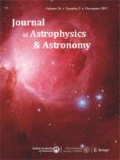Abstract
Precise multi-color CCD-derived photometric data were obtained from EH Cnc at two sites during 2010, 2014 and 2018 wherein each epoch used a different instrument. This has provided a unique opportunity to investigate parameter uncertainty following Roche modeling of light curves optimized by differential corrections using the Wilson–Devinney code. Furthermore, new radial velocity data from EH Cnc presented in this study for the first time has produced absolute physical and geometric parameters for this A-subtype W UMa-type variable. Analysis of eclipse timing data confirms the presence of sinusoidal-like excursions in the eclipse timing residuals. We address whether these are due to magnetic activity cycles, the so-called “Applegate effect”, or related to a light-time effect (LiTE) resulting from the presence of a third gravitationally bound cool low mass white dwarf. A model using the PAdova & TRieste Stellar Evolution Code (PARSEC) has provided valuable insight about the evolutionary history of EH Cnc as a trinary system.












Similar content being viewed by others
Notes
An unnecessary factor \(\omega \) appears in the formula for AML rate in the latter paper. Equation (16) gives the correct expression.
References
Abubekerov M. K., Gostev N. Y., Cherepashchuk A. M. 2008, Astron. Rep. 52(2), 99, https://doi.org/10.1134/s1063772908020030
Abubekerov M. K., Gostev N. Y., Cherepashchuk A. M. 2009, Astron. Rep. 53(8), 722, https://doi.org/10.1134/s1063772909080046
Alton K. B. 2019, J. Am. Assoc. Variable Star Obs. 47, 7
Alton K. B., Nelson R. H. 2018, Mon. Not. R. Astron. Soc. 479(3), 3197, https://doi.org/10.1093/mnras/sty1693
Andrae R., Fouesneau M., Creevey O., Ordenovic C., Mary N., Burlacu A., Chaoul L., Jean-Antoine-Piccolo A., Kordopatis G., Korn A., Lebreton Y., Panem C., Pichon B., Thévenin F., Walmsley G., Bailer-Jones C. A. L. 2018, Astron. Astrophys. 616, 8, https://doi.org/10.1051/0004-6361/201732516
Applegate J. H. 1992, Astrophys. J. 385, 621, https://doi.org/10.1086/170967
Bailer-Jones C. A. L. 2015, Publ. Astron. Soc. Pac. 127(956), 994, https://doi.org/10.1086/683116
Berry R., Burnell J. 2005, The Handbook of Astronomical Image Processing. Willmann-Bell, Inc., Richmond, VA, http://adsabs.harvard.edu/abs/2005haip.book.....B
Binnendijk L. 1970, Vistas Astron. 12, 217, https://doi.org/10.1016/0083-6656(70)90041-3
Bradstreet D. H. 2005, Society for Astronomical Sciences Annual Symposium, Volume 24, p. 23
Bradstreet D. H., Steelman D. P. 2002, in American Astronomical Society Meeting Abstracts. Bulletin of the American Astronomical Society, Volume 34, p. 1224, http://adsabs.harvard.edu/abs/2002AAS...201.7502B
Brát L., Zejda M., Svoboda P. 2007, Open Eur. J. Variable Stars 74, 1
Brát, L., Šmelcer, L., Kučáková, H., Ehrenberger, R., Kocián, R., Lomoz, F., Urbančok, L., Svoboda, P., Trnka, J., Marek, P., Dřevěný, R., Uhlář, R., Poddaný, S., Zasche, P., Skarka, M., 2008, Open Eur. J. Variable Stars 94, 1
Brát, L., Trnka, J., Lehký, M., Šmelcer, L., Kučáková, H., Ehrenberger, R., Dřevěný, R., Lomoz, F., Marek, P., Kocián, R., Svoboda, P., Přibík, V., Urbančok, L., Poddaný, S., Dubovský, P. A., Uhlář, R., Horálek, P., Hanžl, D., Brož, M., Kalisch, T. Macek, O., Exnerová, M., Vítek, M., 2009, Open Eur. J. Variable Stars 107, 1
Brát, L., Trnka, J., Šmelcer, L., Lehký, M., Kučáková, H., Lomoz, F., Hanžl, D., Vrašťák, M., Corfini, G., Přibík, V., Dřevěný, R., Ehrenberger, R., Kocián, R., Mašek , M., Polák, J., Starzomski, J., Marchi, F., Poddany, S., Zejda, M., Cagaš, P., Klos, M., Garofalo, R., Klimentová, J., Kliment, P., Speil, J., Magris, M., Hladík, B., Hoňková, K., Juryšek, J., Smyčka, T., Moudrá, M., Naves, R., Ruocco, N., Zahajský, J., Audejean, M., Pejcha, O., Uhlář, R., Vieira, J., Zasche, P., Zambelli, R., 2011, Open Eur. J. Variable Stars, 137, 1
Bressan A., Marigo P., Girardi L., Salasnich B., Cero C. D., Rubele S., Nanni A. 2012, Mon. Not. R. Astron. Soc. 427(1), 127, https://doi.org/10.1111/j.1365-2966.2012.21948.x
Brown A. G. A., Vallenari A., Prusti T., de Bruijne J. H. J., Babusiaux C., Bailer-Jones C. A. L., Biermann M., Evans D. W., Eyer L., Jansen F., Jordi C., Klioner S. A. 2018, Astron. Astrophys. 616, 1, https://doi.org/10.1051/0004-6361/201833051
Diethelm R. 2003, Inf. Bull. Variable Stars 5438
Diethelm R. 2009, Inf. Bull. Variable Stars 5871
Diethelm R. 2011, Inf. Bull. Variable Stars 5992
Diethelm R. 2012, Inf. Bull. Variable Stars 6029
Eggleton P. P. 1983, Astrophys. J. 268, 368, https://doi.org/10.1086/160960
Eggleton P. P., Kisseleva-Eggleton L. 2006, Astrophys. Space Sci. 304(1–4), 75, https://doi.org/10.1007/s10509-006-9078-z
Everett M. E., Howell S. B. 2001, Publ. Astron. Soc. Pac. 113(789), 1428, https://doi.org/10.1086/323387
Figer A. 1983, GEOS Circular on Eclipsing Binaries 8
Figer A., Le Borgne J. F., Dumont M. 1985, Inf. Bull. Variable Stars 2755
Gazeas K., Stȩpień K. 2008, Mon. Not. R. Astron. Soc, https://doi.org/10.1111/j.1365-2966.2008.13844.x
Hansen B. M. S., Liebert J. 2003, Annu. Rev. Astron. Astrophys. 41(1), 465, https://doi.org/10.1146/annurev.astro.41.081401.155117
Henden A. A., Welch D. L., Terrell D., Levine S. E. 2009, in: American Astronomical Society Meeting Abstracts #214. American Astronomical Society Meeting Abstracts, Volume 214, p. 669. 2009AAS...21440702H
Henden A. A., Terrell D., Welch D., Smith T. C. 2010, in: American Astronomical Society Meeting Abstracts #215. Bulletin of the American Astronomical Society, Volume 42, p. 515. 2010AAS...21547011H
Henden A. A., Levine S. E., Terrell D., Smith T. C., Welch D. L. 2011, in: American Astronomical Society Meeting Abstracts #218. Bulletin of the American Astronomical Society, Volume 43, p. 126. 2011AAS...21812601H
Hoňková, K., Juryšek, J., Lehký, M., Šmelcer, L., Trnka, J., Mašek, M., Urbaník, M., Auer, R., Vrašták, M., Kučáková, H., Ruocco, N., Magris, M., Polák, J., Brát, L., Audejean, M., Banfi, M., Moudrá, M., Lomoz, F., Přibík, V., Dřevěný, R., Scaggiante, F., Kocián, R., Cagaš, P., Poddaný, S., Zíbar, M., Jacobsen, J., Marek, P., Colazo, C., Zardin, D., Sobotka, P., Starzomski, J., Hladík, B., Vincenzi, M., Skarka, M., Walter, F., Chapman, A., Díaz, N. D., Aceti, P., Singh, P., Kalista, L., Kamenec, M., Zejda, M., Marchi, F., Bílek, R., Guzzo, P., Corfini, G., Onderková, K., Hečko, A., Mina, F., Vítek, M., Barsa, R., Quinones, C., Taormina, M., Melia, R., Schneiter, M., Scavuzzo, A., Marcionni, N., Ehrenberger, R., Tapia, L., Fasseta, G., Suarez, N., Scaggiante, D., Artusi, E., Garcia, R., Grnja, J., Fišer, A., Hynek, T., Vilášek, M., Rozehnal, J., Kalisch, T., Lang, K., Gorková, S., Novysedlák, R., Salvaggio, F., Smyčka, T., Spurný, M., Wikander, T., Mravik, J., Šuchaň, J., Čaloud, J., 2013, Open Eur. J. Variable Stars 160, 1
Hu S. M., Li K., Guo D.-F., Jiang Y., Gao D., Chen X. 2015, Publ. Astron. Soc. Jpn. 67(5), 100, https://doi.org/10.1093/pasj/psv069
Hübscher J. 2007, Inf. Bull. Variable Stars 5802
Hübscher J. 2017, Inf. Bull. Variable Stars (6196), https://doi.org/10.22444/IBVS.6196
Hübscher J., Lehmann P. B. 2012, Inf. Bull. Variable Stars 6026
Hübscher J., Lehmann P. B. 2013, Inf. Bull. Variable Stars 6070
Hübscher J., Lehmann P. B. 2015, Inf. Bull. Variable Stars 6149
Hübscher J., Lehmann P. B., Walter F. 2012, Inf. Bull. Variable Stars 6010
Hübscher J., Steinbach H.-M., Walter F. 2009, Inf. Bull. Variable Stars 5874
Irwin J. B. 1959, Astron. J. 64, 149, https://doi.org/10.1086/107913
Kallrath J., Milone E. F., eds, 1999, Eclipsing Binary Stars: Modeling and Analysis. 1999ebs..conf.....K
Kulikovski P. G. 1934, Perem. Zvezdy 4, 294
Kurucz R. L. 2002, Baltic Astron. 11, 101
Kwee K. K., van Woerden H. 1956, Bull. Astron. Inst. Neth. 12, 327
Lee J. W., Park J.-H. 2018, Publ. Astron. Soc. Pac. 130(985), 034201, https://doi.org/10.1088/1538-3873/aaa390
Leggett S. K., Ruiz, M. T., Bergeron, P. 1998, Astrophys. J. 497(1), 294, https://doi.org/10.1086/305463
Lucy L. B. 1967, Z. Astrophys. 65, 89
Maraziti A. 1987, BBSAG Bull. 85, 2
Martignoni M. 1994, BBSAG Bull. 107, 3
Nelson R. H. 2004, Inf. Bull. Variable Stars 5493
Nelson R. H. 2006, Inf. Bull. Variable Stars 5672
Nelson R. H. 2008, Inf. Bull. Variable Stars 5820
Nelson R. H. 2009, https://www.variablestarssouth.org/bob-nelson/
Nelson R. H. 2010a, Inf. Bull. Variable Stars 5929
Nelson R. H. 2010b, https://www.variablestarssouth.org/bob-nelson/
Nelson R. H. 2010c, Spectroscopy for Eclipsing Binary Analysis in The Alt-az Initiative, Collins Foundation Press, Santa Margarita, CA
Nelson R. H. 2013, Inf. Bull. Variable Stars 6050
Nelson R. H. 2015, Inf. Bull. Variable Stars 6131
Nelson R. H. 2016, Inf. Bull. Variable Stars 6164
Nelson R. H. 2017, Inf. Bull. Variable Stars 6195, https://doi.org/10.22444/ibvs.6195
Nelson R. H. 2018, Inf. Bull. Variable Stars 6234, https://doi.org/10.22444/ibvs.6234
Nelson R. H., Şenavci H. V., Baştrk Bahar E. 2014, New Astron. 29, 57, https://doi.org/10.1016/j.newast.2013.11.006
Pagel L. 2018, Inf. Bull. Variable Stars 6244, https://doi.org/10.22444/ibvs.6244
Parimucha S., Dubovský P., Vanko M. 2013, Inf. Bull. Variable Stars 6044
Parimucha S., Dubovský P., Baludansky D., Pribulla T., Hambalek L., Vanko M., Ogloza W. 2009, Inf. Bull. Variable Stars 5898
Parimucha S., Dubovský P., Vanko M., Pribulla T., Kudzej I., Barsa R. 2011, Inf. Bull. Variable Stars 5980
Parimucha S., Dubovský P., Kudak V., Perig V. 2016, Inf. Bull. Variable Stars 6167, arXiv: 1604.03337
Paunzen E., Vanmunster T. 2016, Astron. Nachr. 337(3), 239, https://doi.org/10.1002/asna.201512254
Pecaut M. J., Mamajek E. E. 2013, Astrophys. J. Suppl. Ser. 208(1), 9, https://doi.org/10.1088/0067-0049/208/1/9
Pribulla T., Chochol D., Vittone A. A. 2003, Chin. J. Astron. Astrophys. 3(S1), 361, https://doi.org/10.1088/1009-9271/3/s1/361
Pribulla T., Ruciński S. M. 2006, Astron. J. 131(6), 2986, https://doi.org/10.1086/503871
Prša A., Zwitter T. 2005, Astrophys. J. 628, 426, arXiv: astro-ph/0503361. https://doi.org/10.1086/430591
Randich S., Schmitt J. H. M. M., Prosser C. F., Stauffer J. R. 1996, Astron. Astrophys. 305, 785
Ruciński S. M. 1969, Acta Astron. 19, 245
Ruciński S. M. 1992, Astron. J. 104, 1968, https://doi.org/10.1086/116372
Ruciński S. M. 2002, Astron. J. 124(3), 1746, https://doi.org/10.1086/342342
Ruciński S. M. 2004, in: Maeder A., Eenens P., eds, Stellar Rotation. IAU Symposium, Volume 215, p. 17, https://ui.adsabs.harvard.edu/abs/2004IAUS..215...17R
Samolyk G. 2011, J. Am. Assoc. Variable Star Obs. (JAAVSO) 39, 94
Samus N. N., Pastukhova E. N., Durlevich O. V., Kazarovets E. V. 2018, Res. Astron. Astrophys. 18(7), 083, https://doi.org/10.1088/1674-4527/18/7/83
Schlafly E. F., Finkbeiner D. P. 2011, Astrophys. J. 737(2), 103, https://doi.org/10.1088/0004-637x/737/2/103
Shakhovski N. M. 1955, Astron. Tsirk. 165, 14
Smith T. C., Henden A. A., Starkey D. R. 2011, Society for Astronomical Sciences Annual Symposium, Volume 30, p. 121
Stȩpień K. 2006a, Acta Astron. 56, 199, arXiv: astro-ph/0510464
Stȩpień K. 2006b, Acta Astron. 56, 347, arXiv: astro-ph/0701529
Stȩpień K. 2011, Astron. Astrophys. 531, 18, arXiv: 1105.2627. https://doi.org/10.1051/0004-6361/201116689
Stȩpień K., Kiraga M. 2013, Acta Astron. 63, 239, arXiv: 1403.2302
Stȩpień K., Kiraga M. 2015, Astron. Astrophys. 577, 117, https://doi.org/10.1051/0004-6361/201425550
Stȩpień K., Pamyatnykh A. A., Rozyczka M. 2017, Astron. Astrophys. 597, 87, https://doi.org/10.1051/0004-6361/201629511
Terrell D., Wilson R. E. 2005, Astrophys. Space Sci. 296(1–4), 221, https://doi.org/10.1007/s10509-005-4449-4
Terrell D., Gross J., Cooney W. R. 2012, Astron. J. 143(4), 99, https://doi.org/10.1088/0004-6256/143/4/99
Tian X.-M., Zhu L.-Y., Qian S.-B., Li L.-J., Jiang L.-Q. 2018, Res. Astron. Astrophys. 18(2), 020, https://doi.org/10.1088/1674-4527/18/2/20
Tian Y. P., Xiang F. Y., Tao X. 2009, Astrophys. Space Sci. 319(2–4), 119, https://doi.org/10.1007/s10509-008-9975-4
van Hamme W. 1993, Astron. J. 106, 2096, https://doi.org/10.1086/116788
Vandenbroere J., Dedoch A. 1996, BBSAG Bull. 112, 4
Völschow M., Schleicher D. R. G., Perdelwitz V., Banerjee, R. 2016, Astron. Astrophys. 587, 34, https://doi.org/10.1051/0004-6361/201527333
Šafř J. 2002, B.R.N.O. Contrib. 32, 1
Šafř J., Zejda M. 2000, Inf. Bull. Variable Stars 4888
Šafř J., Zejda M. 2002, Inf. Bull. Variable Stars 5263
Wilson R. E. 1979, Astrophys. J. 234, 1054, https://doi.org/10.1086/157588
Wilson R. E. 1990, Astrophys. J. 356, 613, https://doi.org/10.1086/168867
Wilson R. E., Van Hamme W. 2016, ftp://ftp.astro.ufl.edu/pub/wilson/lcdc2015/ebdoc.6jun2016.pdf
Wilson R. E., Devinney E. J. 1971, Astrophys. J. 166, 605, https://doi.org/10.1086/150986
Yang Y.-G., Shao Z.-Y., Pan H.-J., Yin X.-G. 2011, Publ. Astron. Soc. Pac. 123(906), 895, https://doi.org/10.1086/661527
Zasche P., Liakos A., Niarchos P., Wolf M., Manimanis V., Gazeas K. 2009, New Astron. 14(2), 121, https://doi.org/10.1016/j.newast.2008.06.002
Zejda M. 1995, Contributions of the Nicholas Copernicus Observatory and Planetarium in Brno No. 31 (31)
Zejda M. 2004, Inf. Bull. Variable Stars 5583
Acknowledgements
This research has made use of the SIMBAD database and VizieR services operated at Centre de Donnes astronomiques de Strasbourg, France. Time-of-minima data tabulated in the Variable Star Section of Czech Astronomical Society (B.R.N.O.) website proved invaluable to the assessment of potential period changes experienced by this variable star. The diligence and dedication shown by all associated with these organizations is very much appreciated. This work also presents results from the European Space Agency (ESA) space mission Gaia. Gaia data are being processed by the Gaia Data Processing and Analysis Consortium (DPAC). Funding for the DPAC is provided by national institutions, in particular the institutions participating in the Gaia MultiLateral Agreement (MLA). The Gaia mission website is https://www.cosmos.esa.int/gaia while the Gaia archive website is https://archives.esac.esa.int/gaia. This work has also made use of data from the European Space Agency (ESA) mission Gaia. R.H.N. wishes to thank the staff members at the DAO (Dmitry Monin, David Bohlender) for their usual splendid help and assistance. Special thanks to Prof. Petr Zasche for sharing his simplex code used to obtain LiTE solutions from eclipse timings. Many thanks to the anonymous referee for taking time to critically review and provide very helpful commentary to improve this manuscript.
Author information
Authors and Affiliations
Corresponding author
Appendices
Appendices
1.1 Appendix A: RV error analyses
The error estimate for a given fitted quantity (such as \(K_{1}\), \(K_{2}\), or a derived quantity such as mass) was determined as follows: Let \(Q = f (y_{1}, y_{2},\ldots , y_{n}\)), where \(Q = K_{1}, K_{2},\ldots , y_{i}\) are the individual RV points, and f is a function not known explicitly but recoverable from the Solver fit. If we increase quantity \(y_{i}\) by its estimated error \(\delta y_{i}\) and reapply Solver we obtain a new value, \(Q_{i}^{\prime} = f (y_{1}, y_{2}, \ldots, y_{i} + \delta y_{i},\ldots , y_{n})\). The resulting difference, \(\mid Q_{i}^{\prime} - Q\mid \) may be taken as \(\delta Q_{i}\), a value due to error in point \(y_{i}\). Then, assuming statistical independence, the error in Q is given by the standard formula:
In this case, the number of data points was sufficiently small so that values for all the \(\delta Q_{i}\) were computed. This procedure has been used in other circumstances where the number of points, n, was too many for all values \(\delta Q_{i}\) to be evaluated. In this case, a random sample of points, \(y_{i}\), was taken and results scaled up.
1.2 Appendix B: Derivation of phase-smearing correction (R. H. Nelson)
Let \(I(\lambda ,t)\) equal the instantaneous spectrum, and compute the RVs by a broadening function routine such that
where B is some undefined function. (If the procedures and parameters of the broadening function process are fixed, B will return a unique value for a given input, and is therefore a function.) But, since instantaneous spectra cannot be taken, we need to integrate over some time interval:
At the mid-time, \(t_{m}\), we compute

It follows that since function B is linear (Ruciński 1992; Nelson 2010c),
If the orbit is circular, and outside of eclipse then
where \(\omega =2\pi /P\), K is the amplitude, and P is the period. Then
Set
Then
where \(f=\frac{\sin (x)}{x}\). Typical values of f are 0.95, 0.97, etc. Note that this correction affects only the scale of the RV plots, and cannot change the computed mass ratio. Therefore, the “true” value
Rights and permissions
About this article
Cite this article
Alton, K.B., Nelson, R.H. & Stȩpień, K. A comprehensive investigation of the variable overcontact system EH Cancri. J Astrophys Astron 41, 26 (2020). https://doi.org/10.1007/s12036-020-09641-y
Received:
Accepted:
Published:
DOI: https://doi.org/10.1007/s12036-020-09641-y




